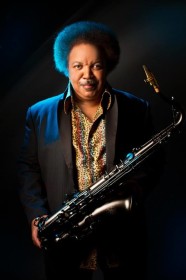
Ron Holloway
(born August 24, 1953, Washington, D.C., United States) is an American tenor saxophonist. He is listed in the Biographical Encyclopedia of Jazz where veteran jazz critic Ira Gitler described Holloway as a “bear-down-hard-bopper who can blow authentic R&B and croon a ballad with warm, blue feeling.” Holloway is the recipient of 42 Washington Area Music Awards, or Wammies, two of which he received as musician of the year.Early years and influences[edit]
Ron Holloway was born to Winston and Marjorie Holloway, avid jazz fans who met while attending Howard University in Washington, D.C. Holloway recalls his father adding to his collection of Prestige and Blue Note jazz albums; something he has kept up until the present day. Holloway’s parents, while not musicians, provided a nurturing musical environment for their son. Holloway’s father favored the saxophone and trumpet-led albums and particularly enjoyed the great horn soloists. R&B-influenced Willis Gator Jackson was easiest to grasp at first, but soon he identified the sounds of Sonny Rollins,[13] John Coltrane and Miles Davis as his principle influences.
After high school graduation, Holloway routinely practiced 8–12 hours a day along with sitting in with bands of all kinds, in jam sessions, which resulted in broadening his versatility. He became familiar with a wide variety of genres. Holloway would frequently perform with jazz, R&B, funk, rock, jazz fusion, blues, country and folk music groups, within the same week. As the Washington D.C. music scene continued to thrive in the 1970s, Holloway joined his first D.C. based bands; popular R&B groups called ‘The Sounds of Shea’ and ‘Mad Dog & the Lowlifers’.
In 1974, Holloway went to see Freddie Hubbard in concert and brought an audio cassette tape he’d made while rehearsing to one of Hubbard’s recordings. During the intermission he introduced himself and played the tape for Hubbard. After hearing the tape, Hubbard invited Holloway to come back and play with him that Sunday night. He did so and at the end of the performance Hubbard extended an open invitation to sit in with him whenever Hubbard was in town. The next year, Sonny Rollins conducted a clinic at Howard University. Backed by a rhythm section composed of local musicians, Rollins invited the young horn players onstage. Holloway joined him on Rollins’ “Playin’ in the Yard”. After his solo, Holloway received a standing ovation from the audience. Rollins and Holloway remained in touch afterwards, becoming good friends. The friendship and respect between the two ran both ways. Rollins has been equally generous in his praise of Holloway over the years and has mentioned him in several interviews as one of his favorite young tenor players. Holloway enjoyed “his sense of organic construction, ambidextrous timing, humorous quotes, swagger, keen sense of drama and unique tonal texture.”
In the summer of 1977 a new club opened and the performers included Rollins, Hubbard and Dizzy Gillespie. Holloway approached Gillespie’s dressing room and as he had done with Rollins, brought a tape with him- this time of his performance with Rollins. After Gillespie listened to the tape, he asked Holloway if he had brought his horn, to which Holloway confessed he hadn’t because he was concerned about appearing presumptuous. Holloway found himself performing with Gillespie all week. Afterwards, he had a standing invitation to sit in with the band. In 1979 Holloway sat in with Dizzy Gillespie at Ronnie Scott’s Jazz Club in London, England. Holloway continued to sit in with Gillespie well into the eighties and on June 6, 1987, performed with a large group of musicians honoring Gillespie at Wolf Trap National Park for the Performing Arts.
Ron has also played with Root Boy Slim and The Sex Change Band, Gil Scott-Heron,Susan Tedeschi and Warren Haynes.
Website

